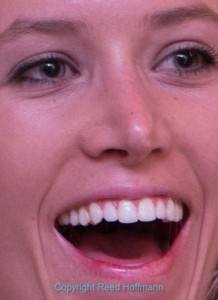A friend recently sent me some photos he was unhappy with, and asked my opinion. Looking at them, I saw he’d done a lot of things right, and had the right idea. But shallow depth of field, and being very critical of image quality were creating his issues. Let’s look at what happened.
First, he did a nice job with exposure. He raised the ISO (to 640) to get a shutter speed/aperture combination (1/100 at f/2.8) that would balance the ambient light with the bounce flash he was adding. He also did a nice job with white balance, as you can see the color looks good. So that worked well. But it also created two problems. The first has to do with sharpness, or more accurately, depth of field.

This photo looks fine, and it really is. However, if you zoom in to 100% (which is how you can see if a picture is truly sharp or not), then you realize neither of the people in the photo is sharp. (Photo copyright Reed Hoffmann)
All four pictures he sent are sharp in some area(s), just not always where he wanted them to be. There are two challenges he’s run into with this. First, shooting wide open, at f/2.8, means he’s going to have a very shallow area of sharp focus (shallow depth of field). Anything much in front or behind that will be out of focus. So when shooting wide open, it’s critical to carefully manage your active AF point to keep it where you want the sharpness. That means you’ll have one thing, or person, sharp, and the rest out of focus to varying degrees.
Second, while shooting at 1/100, f/2.8, 640 ISO balanced the ambient light and flash, that 1/100 second also risks motion blur. This could come from either camera movement or subject movement. He’s shooting a D800E, which at 36-megapixels is recording a ton of detail. And that means that if the camera isn’t rock solid when shooting, especially at any shutter speed under 1/500, you’re risking blur. Add to that any subject movement, and you’re going to get blur there too.

Here I’ve taken that one image and zoomed in to 100% in three different areas. Doing that, you can see that the woman at left is truly out of focus, the bag between them is sharp, and the woman at right nearly sharp. This is a case of the focus being between the two subjects, and since the aperture is at f/2.8, there’s very little depth of field to compensate. (Photo copyright Reed Hoffmann)
With those two issues in mind, I would have suggested a little faster shutter speed (perhaps 1/160) and a smaller aperture (around f/5). Those two adjustments would have lessened the possibility of motion blur and added more depth of field. Of course, to get the same overall exposure, he would have had to raise the ISO as well. However, since he’s using fill flash, he wouldn’t need to raise it as much as you might think. Remember, the flash is providing the primary illumination for the scene, and the ambient light is simply adding some detail to the background. It’s a common practice while shooting fill flash indoors to set the exposure manually, and have it intentionally be underexposed. The flash will then work with the camera to expose the subject properly, and by letting the background go a little darker you actually help keep the viewer’s attention on the subject.

Again, this photo looks fine as is (at this size), but there’s some motion blur, which we’ll see as we zoom in. (Photo copyright Reed Hoffmann)
Finally, there’s an argument to be made against not being too critical of image quality. Think how most photos are going to be viewed. With the D800E recording 36-megapixels, you’ve got 7360 pixels wide by 4912 pixels deep. Most people will never be in front of a monitor that can actually display all those pixels, meaning the image will be viewed at a reduced resolution. For instance, I’m sitting in front of a 23-inch monitor that displays 1920 pixels wide by 1200 pixels deep. If I try to view that D800E image at full resolution, I’ll only see part of it (1920X1200 of the 7360X4912). To see the entire image, either the computer or I need to downsize it to make it fit. Now, if you downsize it yourself, to 2000-pixels maximum width, it will be 2000X1335. And, it will look sharper! That’s because a lot of that fine detail, which was showing it was slightly out of focus and/or there was motion blur, is now gone. And, if you add a small amount of sharpening at the same time you downsize the image, it will look even better. So the smaller you make it, the better it will look. 1000-pixels is usually plenty big for most people to view images on screens.

Zoomed to 100%, you can see the small amount of blur. My guess is that she’s moving as she reacts to the present, and at 1/100 second, that causes the blur. Photo copyright Reed Hoffmann.

With the original image re-sized to 2000-pixels wide (instead of 7360), then zoomed to 100%, it’s harder to see the blur. Photo copyright Reed Hoffmann.
I’m all for being critical of image quality. The goal should be to make the best possible picture in any situation. But remember, I’m saying “the best possible…” Every picture won’t be perfect. There will always be times where you have to balance out quality with whether the photo serves its purpose. We do that all the time when we make choices with exposure. Sure, I’d love to shoot at 100 ISO all the time, but that won’t let me get usable photos in lots of situations. So we’re always balancing out what we’d like to do with what’s possible. That’s why over time I’ve become a big fan of “good enough.” If you were planning to make 60X40 gallery prints from those photos, sure, you’d be disappointed with the results. But for photos of family opening gifts, these are way better than average, and my guess is everyone will love them. They’re plenty good enough. And that’s all that matters.

